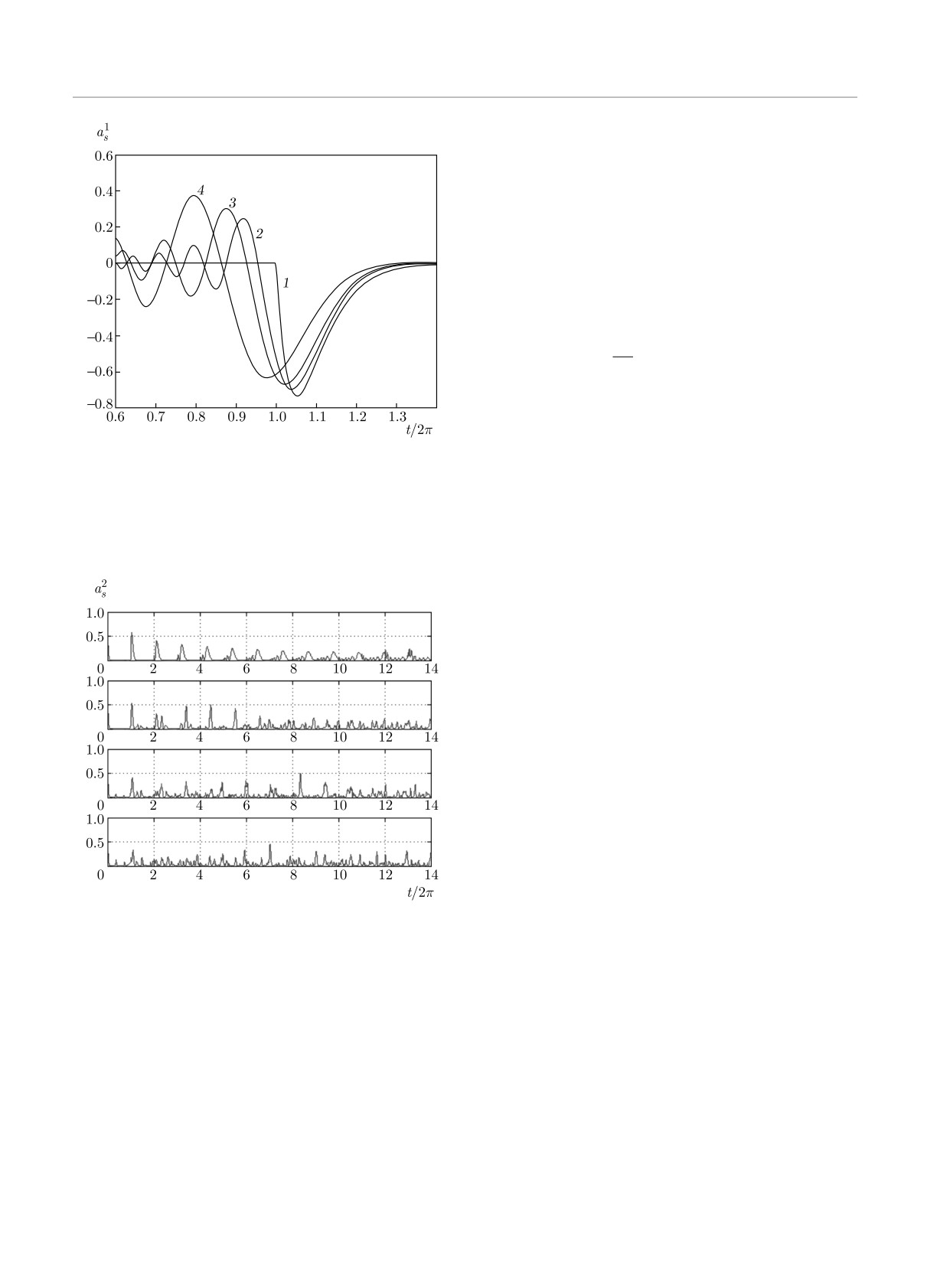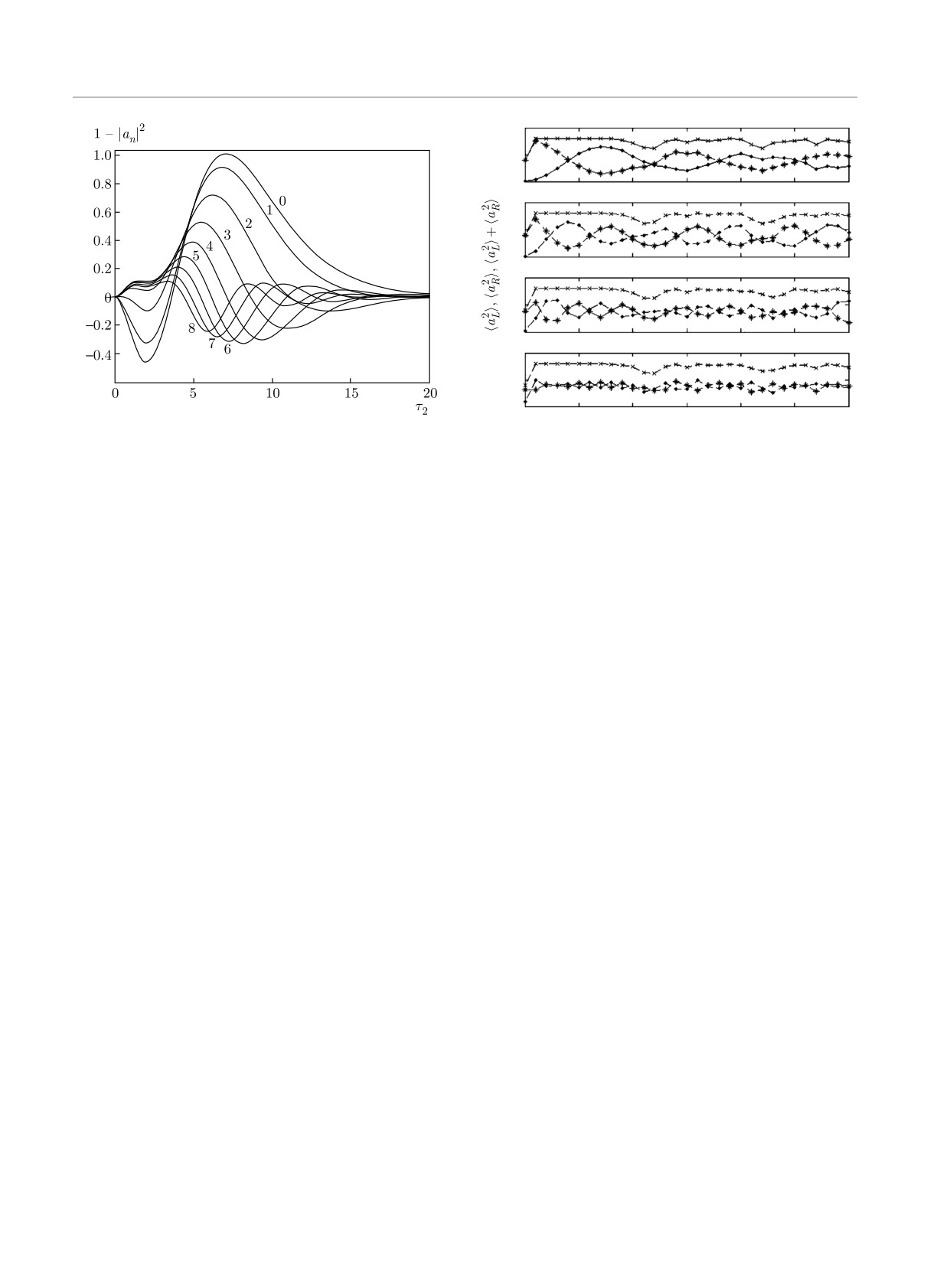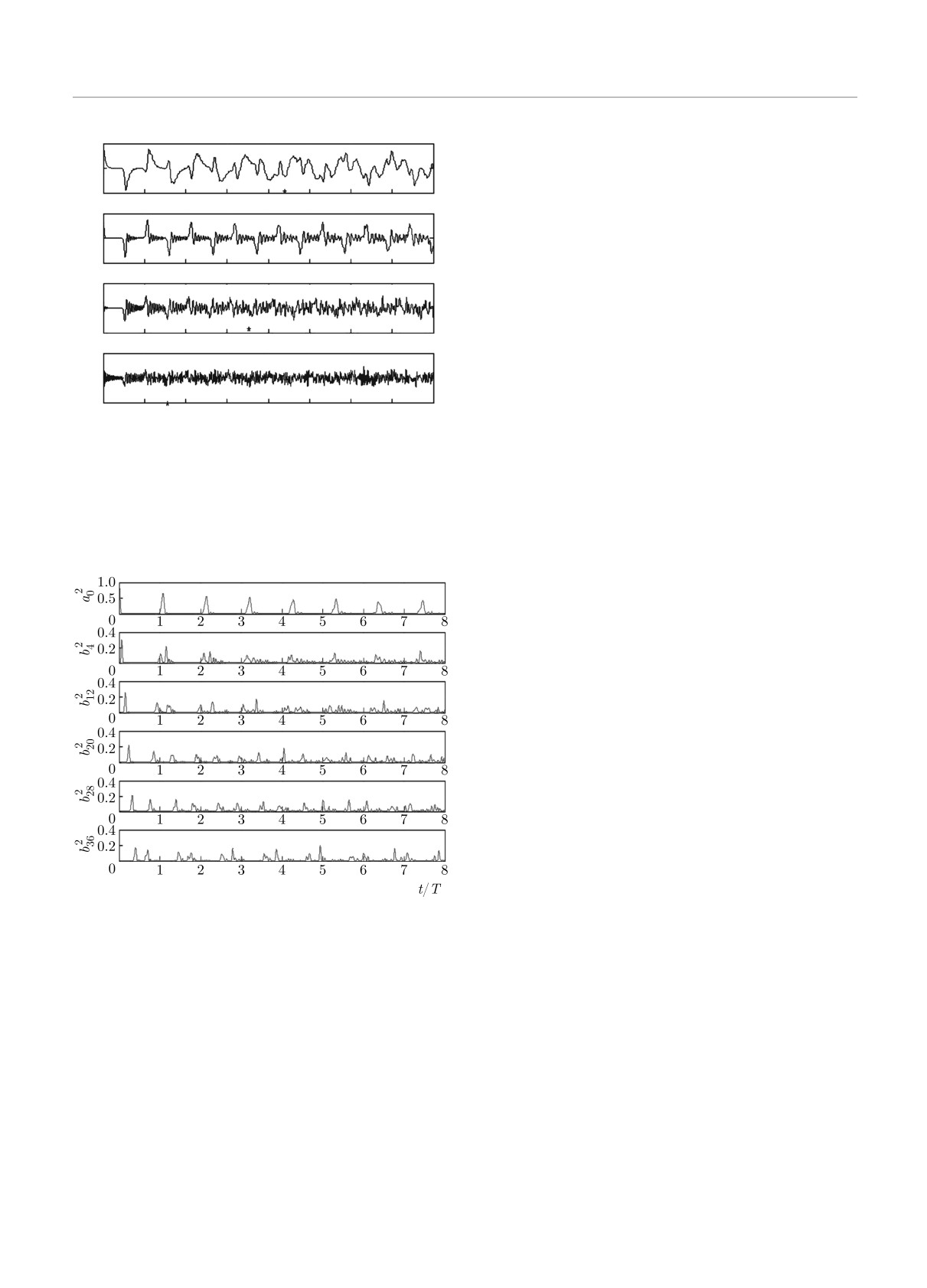ЖЭТФ, 2021, том 160, вып. 4 (10), стр. 491-497
© 2021
NON-TRIVIAL DYNAMIC REGIMES OF SMALL (NANO-SCALE)
QUANTUM SYSTEMS
V. A. Benderskiia, E. I. Katsb*
a Institute of Problems of Chemical Physics, Russian Academy of Sciences
142432, Chernogolovka, Moscow Region, Russia
b Landau Institute for Theoretical Physics, Russian Academy of Sciences
142432, Chernogolovka, Moscow Region, Russia
Received May 18, 2021,
revised version May 24, 2021.
Accepted for publication May 24, 2021
DOI: 10.31857/S0044451021100059
sults in the temperature dependent broadening and de-
cay of the echo components. Another generalization is
Abstract. Small (but still containing many,
to replace a single level by two states coupled to the
about 102-104, atoms) quantum systems (tradition-
Zwanzig reservoir. We anticipate that the basic ideas
ally termed nano-systems) are dramatically different
inspiring our work can be applied to a large variety of
from their macroscopic or genuine microscopic (atomic)
interesting for the applications nano-systems (e. g., dis-
cousins. Microscopic molecular systems (with a few
sipative free propagation of excitations along molecular
atoms) obey a regular quantum dynamics (described
chains, or as a model for exchange reactions).
by time dependent Schrödinger equation), whereas in
macroscopic systems with continuous energy spectra,
Introduction. There are materials which do not
one can expect regular dynamic behavior. The topic
exhibit unusual properties in the nano-scale regime.
of our paper is in-between these limits. Nano-scale
For example, simple non-polar hydrocarbon molecules
systems are characterized by small (but finite) mean
when aggregated are added merely additively. In other
interlevel spacing. In such a case with recurrence pe-
systems, that are under investigation in this work, the
riods in picosecond range, Loschmidt echo and dou-
properties may exhibit anomalous values (or behavior
ble resonance phenomena come into the game. Sys-
of a system is unusual) in the nano-regime. Common
tem behavior becomes non-trivial and manifests a sort
wisdom borrowed from textbooks on quantum mechan-
of transitions between regular and chaotic dynamics.
ics teaches that a population of somehow initially pre-
We show that such dynamic transitions occur when the
pared state of a macroscopic system monotonically de-
Loschmidt echo lifetime exceeds the typical recurrence
creases in time due to the energy flow from this ini-
cycle period. We illustrate this behavior in the frame-
tial state into the states of the reservoir (formed by
work of a few versions of the exactly solvable quan-
all continuous states of the macroscopic system under
tum problem, proposed long ago by Zwanzig [1]. It is
consideration). In the opposite limit (a small system
based on the study of time evolution of the initially
with a few degrees of freedom), system behavior is also
prepared vibrational state coupled to a reservoir with
well known. The system dynamics is reduced to the
a dense spectrum of its vibrational states. In the sim-
recurrence cycles, with their periods (according to the
plest version of the Zwanzig model, the reservoir has
famous Poincare theorem) determined by the lowest ra-
an equidistant spectrum, and the system reservoir cou-
tionally independent interlevel spacings. As it is often
pling matrix elements are independent of the reservoir
the case, an intermediate case (relatively large but not
states. We generalize the model to include into con-
macroscopically large quantum system) is the most dif-
sideration the coupling of the initially prepared single
ficult one for theoretical analysis. However, just such
state to system phonon excitations. The coupling re-
systems (generically termed as nano-systems) contain-
ing about several hundreds of atoms become more and
* E-mail: efim.i.kats@gmail.com
more attractive for various applications.
491
3*
V. A. Benderskii, E. I. Kats
ЖЭТФ, том 160, вып. 4 (10), 2021
as
S
1.0
R
0.5
SR
0
–0.5
–1.0
0
5
10
15
S
as
t
2
R
1.0
0.5
0
S0
–0.5
–1.0
10
15
20
25
30
35
40
Fig. 1. Scheme of radiationless transitions {Rn} ← S accom-
t
2
panying by the optical transition S ← S0 from the ground to
initial state. Direct optical transitions {Rn} ← S0 are forbid-
Fig. 2. The initial state evolution for the bare Zwanzig model:
den. S is the state obtained by the optical pumping from the
as is the amplitude of the optically excited state, C is the SR
ground state S0, {Rn} are the final (reservoir) states, and ΓS
coupling constant, C2 = 1, γs and γn are the widths of the
and ΓR are decay rates for the corresponding states
corresponding energy levels (in the figure, the both γ = 0).
Time is measured in the inverse interlevel spacing of the reser-
voir states. The upper panel shows the initial cycles with the
regular dynamics. The lower panel demonstrates chaotic-like
Our intent in this work is to investigate dynamic
long-time dynamics in the case of the overlapping recurrence
behavior of these intermediate nano-size quantum sys-
cycles
tems. In principle, the full information about the sys-
tem (both dynamics and statics) is naturally contained
in quantum mechanical solution of the corresponding
Schrödinger equation. In practice, however, the quan-
tum solution is unfeasible even for not too large (about
102-104 atoms) systems. Therefore, one has to rely
either on heavy ab initio numeric, or to look for ana-
lytically doable approximations. Luckily for us, many
years ago Robert Zwanzig in a remarkable work (al-
though published not in a regular and easy accessi-
ble journal [1]) proposed a simple (but not trivial) ex-
actly solvable model of quantum dynamics. Within
this model, an initially prepared single state of a quan-
tum system evenly couples to the dense but discrete
spectrum of the reservoir levels. Within the Zwanzig
model, the coupling strength is assumed to be a con-
stant independent of the reservoir levels. Surprisingly
enough that in spite of this evidently erroneous as-
sumption, Zwanzig approximation correctly identifies
Fig. 3. Crossover from the regular to quasi-random spectrum
the dynamic regimes and characteristic time scales in
of the mixed RS states upon the mixing deformation. I(E) is
the spectral density, and energy E is measured in the units of
the problem. Thus, although the Zwanzig model is a
the interlevel spacing; K is sublattices spectra regular splitting,
toy model (in the sense of caricaturing some physical
K = 3 in the computations; δ1 and δ2 are parameters which
features), when properly interpreted it can yield quite
determine the additional (with respect to regular) sublattices
reasonable values for a variety of essential (and prin-
splittings: δ1 = 0, 0.1, 0.4, 0.7 (from the top to the bottom),
cipally measured) quantities. That such a simple the-
and δ2 = 2δ1; C2 = 0.1
ory can predict rather complex and subtle features for
nano-size quantum systems is remarkable.
492
ЖЭТФ, том 160, вып. 4 (10), 2021
Non-trivial dynamic regimes of small...
tems we have in mind. Our topic is nano-size quantum
objects, possessing discrete vibrational energy spectra.
Such objects are carbon nano-tubes, graphene flacks,
metallic clusters, some large organic molecules or their
clusters. Typical feature (relevant for everything what
follows in the paper) of such systems is that their vibra-
tional spectra are discrete and characteristic interlevel
spacing
Δ is on the order of 0.1-10 cm-1. This value
of
Δ is translated into the picosecond time scale for the
periods of the recurrence cycles
2π
T =
cΔ≃10-10-10-12 s,
where c is the light speed. In turn, experimental stud-
ies of the excited state evolution in large (nano-size)
molecular systems [3-8] have established that the pro-
cesses of vibrational relaxation, energy transfer, and
Fig. 4. Backward evolution of the initial state amplitude a1s
ultra-fast chemical reactions occur in the same picose-
for the cycle k = 1. The reservoir posses the increasing inter-
level spacings. C2 = 1. The model parameters describing the
cond time range as recurrence cycles. Therefore, the re-
spectrum deformations are b = 0 and a = 0, 0.15, 0.25, 0.35
currence cycles are essential ingredients to be included
(curves 1-4, respectively)
to describe theoretically such features of the quantum
dynamics of nano-systems as irreversibility, chaotic be-
havior and loss-free distant energy transfer. These and
some other high-resolution experiments (which will be
cited and shortly discussed in our paper) demonstrate
that a system initial vibrational state evolution, as a
rule, has a complicated form with irregular oscillations.
The methods of double resonances in the non-linear
femtosecond spectroscopy [9-12] appear to be espe-
cially useful to observe these irregular oscillations of the
initial and final state populations simultaneously. The
phenomenon has been observed for the wide variety of
large-size molecules in liquid and solid solutions and on
interfaces [13-18]. Note to the point that irregular os-
cillations of the population of initially prepared excited
state have been confirmed by the numerous quantum
dynamical calculations [19-23].
The loss-free excitation energy transfer, observed
in linear molecules consisting of 12-26 CH2 fragments
[20, 21], also belongs to a similar class of irregular in
Fig. 5. Time evolution of the initial state coupled to reservoir
time behavior. In such kind of experiments, the ini-
with spectral mixing for the cycle k = 1: C2 = 1, K = 3,
tial excitation of the molecular terminal group pro-
δ2 = 2δ1, δ1 = 0, 0.019, 0.049, 0.079, a = 0, 0.15, 0.25, 0.5
(from the top to the bottom), and b = 0
duces the running wave with approximately constant
speed (about of 2 ps per one fragment). Even more
surprising is that instead of naively expected random
Here we compile a brief self-contained review that
distribution of the excitation energy over the total set of
we wish had existed when we first entered the field
intra-molecular modes, the wave propagation lasts dur-
[2]. In what follows in the frame work of generalized
ing several passages along the chain before the uniform
Zwanzig approach, we study a number of nano-size
distribution is established. The distant energy transfer
quantum systems. Since our work is primary about
occurs between localized vibrations of fragments sepa-
physics (and only then how it can be modeled theoret-
rated by about 1 nm distance during 20-40 ps whereas
ically), it is worth to note first what are physical sys-
the lifetime of these vibration excitations themselves
493
V. A. Benderskii, E. I. Kats
ЖЭТФ, том 160, вып. 4 (10), 2021
0.4
0.2
0
5
10
15
20
25
30
0.4
0.2
0
5
10
15
20
25
30
0.4
0.2
0
5
10
15
20
25
30
0.4
0.2
0
5
10
15
20
25
30
k
Fig. 6. Redistribution of the initial-state population over the
mixed reservoir states with the amplitudes an during the sec-
Fig. 7. Variation of the average per cycle populations of L0 (♦)
ond recurrence cycle k = 2 with duration τ2. The numbers of
and R0 (∗) states and the entire population of the two-level
the reservoir states are shown near the curves
systems (×) in the recurrence cycles versus the cycle num-
ber k: C2 = 1 and the two-level splitting Δ = 0.4, 1.2, 2.7,
7.4 (from the top to the bottom)
does not exceed 3 ps. The matter is that the excita-
tion energy transfer includes intermediate excitations
of delocalized long-lived vibrations binding the initial
model. In these works, we also proposed a method
and final fragments [22-25].
which makes it possible to solve the dynamical prob-
These data permit to suggest that the irregular
lem analytically beyond the bare Zwanzig model ap-
evolution is the generic property of the systems with
proximations [27-32]. The main ingredient of our new
dense discrete spectra. Therefore, the role of the reser-
method (only schematically and briefly described in the
voir with a discrete spectrum is fundamentally differ-
previous papers) is the representation of the partial
ent from that with a continuous spectrum typical for
amplitudes of recurrence cycles. Unlike the standard
macroscopic systems. In the latter case (with the infi-
Fourier expansion over eigen-frequencies, this represen-
nite recurrence period time), the reservoir serves as a
tation reveals explicitly the time dependent exchange
sink for energy flow. Contrary in the case of the discrete
between intramolecular states in each recurrence cycle.
spectrum, repetitive reverse transitions from the reser-
The fine structure of the Loschmidt echo arises as a
voir to the initial state and in the opposite direction
result of the dephasing phenomena associated with the
determine the non-trivial and often irregular long-time
fact that the exchange of the different reservoir states
dynamics. The synchronization of these reverse tran-
with the initial state occurs not at the same instants
sitions results in the appearance of a multi-component
of time. The synchronization of the reverse transitions
Loschmidt echo phenomenon with a partial recovery
is destroyed when the Loschmidt echo components of
of the initial state population (at the frequency corre-
the different recurrence cycles start to overlap. The cy-
sponding to the initial excited state energy), and double
cle overlapping determines the critical recurrence cycle
resonances (at the frequencies of the reservoir states).
number. Then at larger time (cycle numbers), the sys-
Both effects are responsible for non-monotonic time
tem dynamics is expected to be in the stochastic-like
evolution. The counterpart of such behavior is the peri-
regime.
odic energy concentration in one of the vibration mode,
Since that time, we have realized that the quan-
arising as a result of the time-dependent exchange be-
tum dynamics of nano-size systems is much richer than
tween reservoir states far from equilibrium.
that predicted for the systems with continuous spec-
In a few of previous works of our group [2, 26-32],
tra, and that non-monotonous in time and irregular
we illustrated how such complex behavior might ap-
dynamics is a robust and generic feature of almost ar-
pear in the frame work of the simple Zwanzig model,
bitrary quantum system with 102-104 degrees of free-
and how the simplest version of the model can be gen-
dom. Moreover, the regular-stochastic dynamic transi-
eralized to relax some unphysical assumptions of the
tion (crossover) yields to a loss of the expected one-to-
494
ЖЭТФ, том 160, вып. 4 (10), 2021
Non-trivial dynamic regimes of small...
a0
our method on a number of particular physical real-
1
izations (only partially overlapping with those in the
0
previous works). The aim to present this review arises
from the conviction that unifying our previous works
–1 0
2
4
6
8
10
12
14
16
1
supplemented by the new applications of the developed
theoretical approach and by new experimental data and
0
observations collected in very recent year, yield to a
–1 0
2
4
6
8
10
12
14
16
new stage of development of this field: dynamics of
1
nano-systems.
0
Our manuscript is divided into 7 sections. After this
Introduction, in Sec. 2 of the full text of this paper, we
–1 0
2
4
6
8
10
12
14
16
1
summarize shortly the results on quantum dynamics of
0
the bare Zwanzig model. A possible physical realiza-
tion most closely satisfying the model assumptions is
–1
0
2
4
6
8
10
12
14
16
also discussed. Section 2 contains also an extended list
t/T
of references to compensate partially its brevity. Then,
in Sec. 3 utilizing developed in our works [27-32] the-
Fig. 8. Dynamics of the population at the excited impurity cite
located in the middle of the finite N = 49 size chain: a0 is
oretical approach, we investigate with all details the
the amplitude of the initially excited site; C2 = 0.1, 0.25, 0.5,
evolution of the population of the initially prepared
0.95 from the top to the bottom; the critical cycle number
single state of the system. In Sec. 4, we analyze var-
kc is marked by the a star (kc = 23 for C2 = 0.5); T is the
ious physically motivated generalizations of the bare
reccurence cycle period
Zwanzig model and how our analytical method should
be modified to describe theoretically these generaliza-
tions. In the same section, we show that on the similar
footing we can study dynamics not only for an indi-
vidual (single) nano-system but as well for the ensem-
ble of somehow distributed nano-systems. We investi-
gate the reservoir states evolution in Sec. 5. We collect
some already discussed in literature and new applica-
tions of our approach to physically interesting phenom-
ena in nano-systems, namely, two-level systems coupled
to reservoir, propagation of vibrational excitations in
nano-size chains (Sec. 6). The last Sec. 7 summarizes
the main findings of our work, with a discussion of pos-
sible physical consequences and interpretation of the
results.
The results from the list of Refs. [1-69] are used
or/and discussed in our work.
The figures illustrated our results are presented be-
Fig. 9. Impurity site excitation propagated along the chain.
low.
C2 = 0.5, N = 49. The site numbers are indicated on the
panels as the subscripts of corresponding values along the ver-
Conclusion. Understanding all limitations of our
tical axes
simplified exactly solvable models, nevertheless we
hope that the results collected in this review capture
the essential peculiarities in nano-system dynamics.
one correspondence between system spectrum and its
Namely, the dense discrete spectra characteristic for
long-time dynamics. For all our examples, the spec-
nano-particles and large-size molecules are responsible
trum remains deterministic, while long-time dynamics
for appearance of recurrence cycles. By contrast to
eventually becomes stochastic. This unusual combina-
macroscopic systems with the continuous spectra,
tion is the specific feature of nano-systems.
where the initial state population decreases mono-
Motivated by this new understanding, we decided
tonically in time, the Loschmidt echo and double
to combine altogether our previous works to illustrate
resonances arise in each recurrence cycle. The revivals
495
V. A. Benderskii, E. I. Kats
ЖЭТФ, том 160, вып. 4 (10), 2021
in the time evolution makes it possible the emergence
13.
C. J. Fesko, J. D. Eaves, J. J. Loparo, A. Tokmakoff,
of new mechanisms of vibration stimulated processes
and P. L. Geissler, Science 301, 1698 (2003).
in single nano-particles and their ensembles as well.
14.
M. Khalil, N. Demirdoven, and A. Tokmakoff,
The regular behavior in the initial recurrence cycles
J. Chem. Phys. 121, 362 (2004).
transformed into chaotic-like long-time evolution is
an inherent characteristic of nano-world. The combi-
15.
A. V. Benderskii and K. B. Eisenthal, J. Phys. Chem.
A 106, 7482 (2002).
nation of the deterministic spectra with chaotic-like
long-time dynamics has no analogs in the quantum
16.
M. L. Cowan, B. D. Bruner, N. Huse, J. R. Dwyer,
dynamics of the macroscopic dissipative systems.
E. T. J. Nibbering, T. Elsaesser, and R. J. D. Miller,
Owing to specific mechanisms of energy transfer and
Nature 434, 199 (2005).
redistribution within the manifold of intramolecular
17.
F. Gai, K. C. Hanson, J. C. McDonald, and P. A. An-
modes, the loss-free and distant energy transfer be-
finrud, Science 279, 1886 (1998).
comes possible. The unique property of nano-systems
is the possibility for periodical accumulation of the
18.
S. Sportlein, H. Cartens, H. Satzger, C. Renner,
energy on the selected vibrational modes. The new
R. Beherendt, L. Moroder, P. Tavan, W. Zinth, and
fields for experimental studies and applications of this
J. Wachveitl, PNAS 99, 7998 (2002).
unusual effect are opened.
19.
D. M. Leitner and P. G. Wolynes, J. Phys. Chem.
A 101, 541 (1997).
The full text of this paper is published in the English
version of JETP.
20.
M. Ben-Nun, F. Molnar, H. Lu, J. C. Phillips,
T. J. Martinez, and K. Schulten, Farad. Discuss. 110,
447 (1998).
21.
G. K. Paramonov, H. Naundorf, and O. Kuhn, Eur.
REFERENCES
Phys. J. D 14, 205 (2001).
1.
R. Zwanzig, Lect. Theor. Phys. 3, 106 (1960).
22.
S. Hayashi, E. Tajkhorshid, and K. Schulten, Bio-
phys. J. 85, 1440 (2003).
2.
V. A. Benderskii, L. A. Falkovsky, and E. I. Kats,
JETP Lett. 86, 221 (2007).
23.
H. Fujisaki, Y. Zhang, and J. E. Straub, J. Chem.
Phys. 124, 144910 (2006).
3.
T. User and W. H. Miller, Phys. Rep. 199, 7 (1991).
24.
Z. Wang, J. A. Carter, A. Laguchev, Y. K. Koh,
4.
Time-resolved Vibrational Spectroscopy, ed. by S. Ta-
N.-H. Seong, D. C. Cahil, and D. D. Dlott, Science
kahashi, Springer, Berlin (1992).
317, 787 (2007).
5.
A. H. Zewail, Femtochemistry: Ultrafast Dynamics of
25.
J. A. Carter, Z. Wang, and D. D. Dlott, Acc. Chem.
Chemical Bonds, World Sci., Singapore (1994).
Res. 42, 1343 (2009).
26.
V. A. Benderskii, L. N. Gak, and E. I. Kats, JETP
6.
M. D. Feyer, Ultrafast Infrared and Raman Spectro-
scopy, Marcel Dekker, New York (2001).
108, 159 (2009).
27.
V. A. Benderskii, L. N. Gak, and E. I. Kats, JETP
7.
A. H. Zewail, Phil. Trans. Roy. Soc. London A 364,
109, 505 (2009).
315 (2005).
28.
V. A. Benderskii and E. I. Kats, JETP Lett 88, 338
8.
D. M. Leitner, Adv. Chem. Phys. B 130, 205 (2005).
(2008).
9.
S. Mukamel, Principles of Nonlinear Spectroscopy,
29.
V. A. Benderskii and E. I. Kats, Eur. Phys. J. D 54,
Oxford Univ. Press, New York (1995).
597 (2009).
10.
R. M. Hochstrasser, PNAS 104, 14190 (2007).
30.
V. A. Benderskii and E. I. Kats, JETP Lett. 92, 370
(2010).
11.
J. Bredenbeck, A. Chosh, M. Smith, and M. Bohn,
J. Amer. Chem. Soc. 130, 2152 (2008).
31.
V. A. Benderskii and E. I. Kats, JETP 113, 562
(2011).
12.
J. B. Ashbury, T. Steinel, C. Stromberg, S. A. Or-
cell, C. P. Skinner, and M. D. Feyer, J. Phys. Chem.
32.
V. A. Benderskii and E. I. Kats, JETP Lett. 94. 459
A 108, 1107 (2004).
(2011).
496
ЖЭТФ, том 160, вып. 4 (10), 2021
Non-trivial dynamic regimes of small...
33.
R. D. Mattuck, A Guide to Feynmann Diagrams in
52.
O. Bohigas, S. Tomsovic, and D. Ulmo, Phys. Rep.
Many-Body Problem, McGraw-Hill, New York (1976).
223, 43 (1993).
53.
T. Papenbrock and H. A. Weidenmuller, Rev. Mod.
34.
G. M. Zaslavsky, Chaos in Dynamical Systems, Har-
Phys. 79, 997 (2007).
wood, New York (1985).
54.
W. Dietz and S. F. Fischer, J. Chem. Phys.113, 2741
35.
M. Tabor, Chaos and Integrability in Nonlinear Dy-
(2000).
namics, J. Wiley, New York (1989).
55.
D. V. Kurochkin, S. R. G. Naraharisetty, and
36.
M. E. Flatte and M. Holthaus, Ann. Phys. 245, 113
I. V. Rubtsov, PNAS 104, 14209 (2007).
(1996).
56.
S. G. Naraharisetty, V. M. Kysanenko, and I. V. Rub-
37.
F. M. Izrailev, Phys. Rep. 196, 299 (1990).
tsov, J. Chem. Phys. 128, 104502 (2008).
38.
W. H. Zurek, Phys. Rev. D 26, 1862 (1982).
57.
I. V. Rubtsov, Acc. Chem. Res. 42, 1385 (2009).
39.
P. Grigolini, Quantum Mechanical Irreversibility,
58.
Z. Smedarchina, W. Siebrand, and M. Z. Zgierski,
World Sci., Singapore (1993).
J. Chem. Phys. 103, 5326 (1995).
40.
Ya. G. Sinai, Introducrion to Ergodic Theory, Prince-
59.
V. A. Benderskii, A. V. Vetoshkin, L. von Laue, and
ton Univ. Press, Guilford (1977).
H. P. Trommsdorff, Chem. Phys. 219, 119 (1997).
41.
M. V. Berry, Chaotic Behavior in Deterministic Sys-
60.
V. A. Benderskii, V. A. Vetoshkin, and H. P. Tromm-
tems, ed. by G. Cassati, Plenum Press, New York
sdorff, Chem. Phys. 234, 173 (1998); 244, 273 (1999);
(1985).
262, 393 (2000).
42.
F. Haake, Quantum Signatures of Chaos, Springer,
61.
G. V. Milnikov and H. Nakamura, Phys. Chem.
Berlin (1990).
Chem. Phys. 10, 1374 (2008).
43.
C. Keating, B. A. McClure, J. J. Rack, and I. V. Rub-
62.
A. J. Leggett, S. Chakravarty, A. T. Dorsey,
tsov, J. Chem. Phys. 133, 144513 (2010).
M. P. A. Fisher, A. Garg, and M. Zwerger, Rev. Mod.
Phys. 59, 1 (1987).
44.
H. Kuzmany, B. Burger, A. Thess, and R. E. Smalley,
Carbon 36, 709 (1998).
63.
V. A. Benderskii, D. E. Makarov, and C. A. Wight,
Chemical Dynamics at Low Temperatures, J. Wiley,
45.
V. Schettino, H. Prigolini, and G. Cardini, J. Phys.
New York (1994).
Chem. A 106, 1815 (2002).
64.
A. O. Caldeira and A. J. Leggett, Ann. Phys. 149,
46.
S. Adhikari and R. Chowdhury, Phys. Lett. A 375,
374 (1983).
2166 (2011).
65.
A. I. Larkin and Yu. N. Ovchinnikov, JETP 58, 876
47.
T. Ishioka, W. Yan, H. L. Strauss, and R. G. Snyder,
(1983); 59, 420 (1984); 60, 1060 (1984).
Spectrochem. Acta A 59, 671 (2003).
66.
B. I. Ivlev and Yu. N. Ovchinnikov, JETP 66, 378
48.
L. Van Hove, Physica 21, 517 (1955).
(1987).
49.
L. D. Landau and E. M. Lifshitz, Statistical Physics,
67.
L. H. Yu, Phys. Rev. A 54, 3779 (1996).
Pt. 1, Pergamon, Oxford (1977).
68.
H. Bateman and A. Erdelyi, Higher Transcendental
50.
L. H. Yu and C. P. Sun, Phys. Rev. A 49, 592 (1994).
Functions, McGraw Hill, New York (1953).
51.
M. L. Mehta, Random Matrices, Acad. Press, New
69.
F. W. J. Olver, Asymptotics and Special Functions,
York (1968).
Acad. Press, New York (1974).
497






